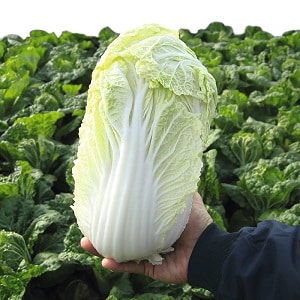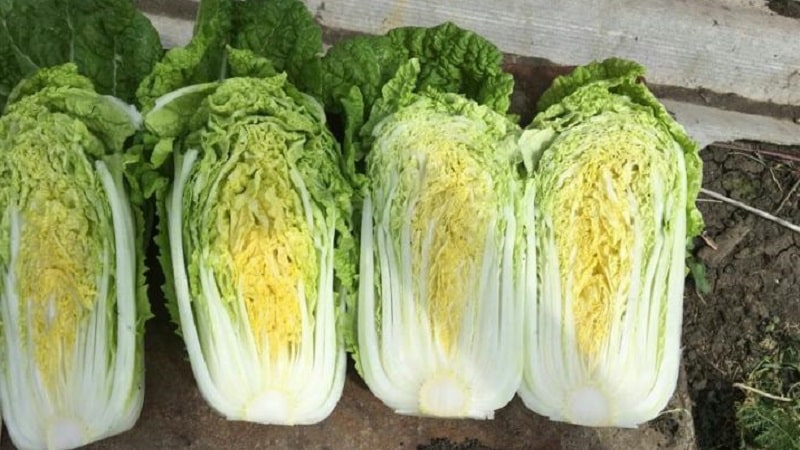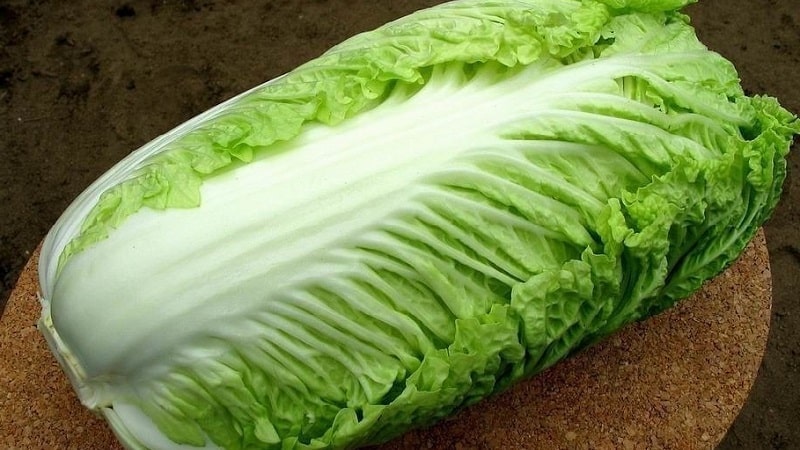Beijing cabbage: description, photos, main characteristics of varieties and hybrids
Peking cabbage looks natural on supermarket shelves, but is still rarely found in garden beds. And in vain, because this vegetable is a source of valuable vitamins and microelements, and growing it is no more difficult than ordinary cauliflower or white cabbage. The main thing is to choose the right variety.
General description of Chinese cabbage leaf
Chinese cabbage is a salad vegetable. The crop is considered biennial, although in most cases it is grown as an annual.
It is characterized by such features:
- The lower leaves are entire, collected in a tight rosette and can reach 15-30 cm in length.
- The leaf blades are slightly wrinkled, with a wavy edge with a slight waxy coating.
- The color of the leaves depends on the variety, but ranges from light to rich green.
- The leaves contain a lot of protein, vitamins A, C and group B.
Peking is very demanding on soil fertility. At the same time, it is capable of accumulating nitrates, so it is better not to buy vegetables in the supermarket if you have the opportunity to grow them yourself in the garden.

The best varieties and varieties of Chinese cabbage
Like other types of cabbage, Chinese cabbage comes in early, mid-season and late varieties.. Among them there are also varieties and hybrids resistant to flowering and bolting. They are grown in areas with less than 12 hours of daylight or in regions with rainy climates.
Reference. Early varieties of Pekinka are most suitable for fresh consumption.They reach technical maturity 36-41 days after emergence, and their leaves are tender and crisp.
Middle and late varieties of the crop have a dense head and thick leaves. These vegetables are suitable for long-term storage and heat treatment. Each variety and hybrid has its own characteristics.
The early group is the largest:
 Manoko F1 (pictured on the right) is a Dutch hybrid intended for cultivation in almost all climatic regions. The vertical rosette of leaves is medium in size, with wide green leaves. The leaf vein is white, wide and flat. The weight of one head of Manoko cabbage reaches 1.5 kg.
Manoko F1 (pictured on the right) is a Dutch hybrid intended for cultivation in almost all climatic regions. The vertical rosette of leaves is medium in size, with wide green leaves. The leaf vein is white, wide and flat. The weight of one head of Manoko cabbage reaches 1.5 kg.- Champion – an early ripening variety with high yield. Heads of cabbage are of moderate density. The leaves are light green. The maximum weight of heads of cabbage is 2.5 kg. It is resistant to diseases and unfavorable climatic conditions.
- Khibiny: heads of cabbage reach technical maturity 50 days after emergence. The shape of cabbage resembles an elongated barrel. The surface of the leaves is highly bubbly. The variety is resistant to flowering and fusarium. The heads of cabbage are not very large - from 0.8 to 1.5 kg.
- Yuki F1 – a hybrid with early ripening. The weight of the head of cabbage reaches 2 kg. Is immune to most cruciferous diseases. Suitable for growing in greenhouses and open ground.
- TSHA 2 – a hybrid with high resistance to bolting. At the same time, the heads of cabbage are loose, and the leaves do not fit tightly to each other. The mass of heads of cabbage is small - no more than 0.5 kg, but they ripen in 35-50 days from the moment of emergence.
Take note:
There are fewer mid-season varieties and hybrids, but among them there are also ones worthy of growing in the garden:
- Bilko F1 (photo below) is a hybrid, the heads of cabbage of which ripen 60-70 days after planting the seedlings. The leaves are wide, painted a rich green color, and have pronounced bubbly. In cross section, the head of cabbage is yellow, and its weight does not exceed 1.8 kg.
- Miraco F1 – an unpretentious hybrid, resistant to drought and flowering. The leaves are medium in size and yellow-green in color. Weight of heads of cabbage – 1 kg. The vegetable is not intended for long-term storage, but the leaves retain their taste and beneficial properties during heat treatment.

Early and mid-season cabbage does not last long. If the vegetable is needed specifically for long storage, it is better to give preference to late varieties and hybrids.
Read also:
Ornamental cabbage: features and description of varieties
Best proven:
- Nika F1 – a hybrid of Russian selection, adapted for cultivation in temperate climates. Heads of cabbage ripen 75-80 days after emergence. The rosette is vertical, of medium height. The leaves are wrinkled, dark green, and have a waxy coating. Weight reaches 3 kg. The vegetable is intended to be stored in the refrigerator for up to 3 months.
- Autumn Jade F1 (pictured) is a hybrid intended for cultivation in the second half of summer. As a result, heads of cabbage are removed from the garden in mid-September, and in the south - in early October. Cabbage is medium dense, has an elongated shape and a yellow core. Average weight is about 2 kg.

Red or purple
The shape of the head of red Chinese cabbage is practically no different from the usual green cabbage., but its leaves are painted a rich purple color (see photo).This crop appeared as a result of breeding work and is gradually beginning to become popular among vegetable growers.
Reference. Purple pekinka is considered healthier, since its leaves contain 2 times more vitamin C than traditional green heads of cabbage.
At the moment, red Beijing seeds are produced only by the Japanese company Kitano Seeds. The hybrid is called KS 888 F1.
 It is characterized by such features:
It is characterized by such features:
- Heads of cabbage reach technical maturity 60-65 days after planting.
- The leaves contain more nutrients than traditional green varieties and have a distinct flavor.
- The culture is resistant to temperature changes and easily adapts to any soil growing conditions.
- The weight of the head of cabbage reaches 1.5 kg. The leaves are succulent and corrugated.
In the refrigerator, the vegetable will remain fresh for 4-5 months without loss of beneficial properties and taste.
Varieties and hybrids resistant to flowering
Because the Pekinka is a biennial crop, in the second year of cultivation it throws out an arrow with seeds. This vegetable is no longer suitable for consumption. And if it is a hybrid, the seedlings grown from its seeds will not retain the characteristics of the mother plant.
Reference. Given this feature, most summer residents prefer to choose hybrids and varieties that are resistant to the formation of flower shoots.
The best hybrids resistant to flowering are considered:
- Cha-cha F1 - Russian Pekinka, adapted for cultivation in the climate of the Middle Zone. Suitable for greenhouses and open ground. The heads of cabbage are dense, have the shape of an elongated barrel, weighing up to 2.5 kg. From the emergence of seedlings to technical maturity, 55-60 days pass.The culture is unpretentious and disease-resistant, but the heads of cabbage are unsuitable for long-term storage.
- Richie F1 – a Japanese hybrid with excellent taste. It is considered mid-early, since the technical maturity of heads of cabbage is reached 75 days after emergence. The mass of heads of cabbage is no more than 1 kg. The crop is resistant to disease and flowering, but has low yield even when grown on fertile soil.
- Brocken F1 - a hybrid that was specially bred in such a way that the rosette does not prematurely throw out the flower arrow. The heads of cabbage are dense and juicy and can be stored in the refrigerator for up to 4 months.

Dutch varieties
Despite the fact that Chinese cabbage is considered a traditional vegetable for Asian countries, It was Dutch breeders who created unique high-yielding hybrids.
Recently a completely new Dutch hybrid Kewstar F1 appeared on the market. It was created specifically for cultivation in temperate and northern climates. Seedlings can be planted both in open ground and in a greenhouse.
From the moment of sowing to the formation of heads of cabbage, 65-70 days pass. The rosette is large, the leaves are light green, moderately wavy along the edges. The crop is characterized by high yield, excellent taste and resistance to flowering, but its seeds are difficult to find in retail sales.
Conclusion
For a long time, summer residents were afraid to plant Chinese cabbage in their gardens. Many people still mistakenly believe that this is a very capricious culture that requires a lot of attention. In fact, it is enough to choose the variety wisely and choose a sunny area with fertile soil for the cabbage.
Experienced gardeners recommend choosing cabbage that is resistant to flowering.In addition, it is advisable to plant early, mid- and late-ripening Pekin varieties in the garden so that you always have access to fresh vegetables during the season.